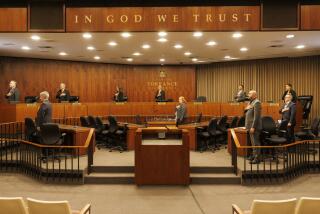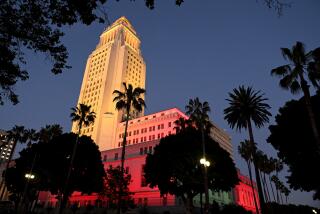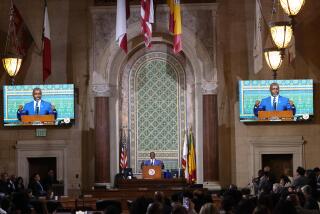The Imbalance of Power in City Hall : City Council: Its members aren’t paid enough for what they do; the question is, should they do so much? And shouldn’t the mayor have greater powers?
- Share via
A Times headline screams “L.A. Council Already Is Highest-Paid in U.S.,” and leads into a seven-city comparison that has all the analytic value of comparing grapefruits to boxcars. The real issue is not how much City Council members should be paid, but what they should be asked to do.
The council members traditionally play a role that is unique among the nation’s mega-city legislators. While exercising all final and many pre-final legislative, planning, zoning and contracting powers, they also cede far less administrative authority to the mayor and habitually micromanage in ways that would not be tolerable most anywhere else. If there is to be a public debate about how much council members should be paid, the basic issue is whether the electorate wants their roles to continue unchanged. Regrettably, this question is not addressed in the pending ballot item that would raise their salaries to $86,157.
On controversial issues, the narrow political interests of any elected politician are usually much better served by hidden than visible exercise of power. It is far safer if an officeholder can control or strongly influence a controversial policy or decision without being publicly seen in the act. The first Mayor Richard Daley of Chicago (the current mayor’s father) was the undisputed heavyweight champion at acquiring and exercising hidden power. Daley had modest formal authority, but he was the absolute monarch of a party and patronage system that controlled virtually all executive, legislative and “independent” district decision mechanisms. That made Daley the strongest “weak” mayor of this century.
But even the Chicago mayoralty is far stronger in formal terms than its Los Angeles counterpart. The fact that the Chicago City Council meets only twice a month demonstrates that it does not, and is not expected to, perform the executive role. It is a legislature. Each of its 50 members represents only 60,000 people, and twice-monthly meetings suffice to address their needs through legislative functions.
The contrast with Los Angeles is dramatic.
As deputy mayor of New York in the early 1970s, I occasionally attended national Mayors’ Conference functions. Sam Yorty was Los Angeles’ mayor then, and he took a lot of teasing from his peers for his national and international traveling habits, which few other full-time mayors could imagine emulating without provoking a voter revolt. His ready rejoinder was along the lines of: “What have I got to stay home for? What can I really do vis-a-vis the City Council, the entrenched department heads and the phalanx of key agencies beyond mayoral control?”
Tom Bradley’s greatest of several claims to fame among his peers across the nation is that he has made so much of so little for so long. Through sheer personal presence and dignity, reasonably good management of constituency and media relations, and an adroit feel for which issues to address and when, he has magnified his influence over city government out of all proportion to his formal authority. This accounts for the fact that many of his most important successes (rail transit, for instance) have been in areas where he has virtually no formal administrative or financial power. He has used informal means to become a real force in the issue areas in which he chooses to intervene. He has been so successful that he has come perhaps halfway toward what most of the citizens who voted for him believe a mayor can do and should be held accountable for.
But the price of forcing the mayor to rely mostly on informal powers has been the growth of habits of hidden power in municipal administration. To the extent that recent allegations of cronyism among some of Bradley’s subordinates prove out, they are the unmistakeable signs of invisible power lines. The bureaucracy, long accustomed to attempted micromanagement by other politicians on the City Council, tries to be responsive to political power centers even where it is not required or supposed to be. The de facto power structure increasingly diverges from the de jure one. The first casualty is accountability; the second is the long-term average quality of city employees, decisions and services.
The right response is probably not to raise City Council salaries, but to realign the city structure so that the mayor can visibly function as head of the executive branch, and the council members can function as full- or part-time legislators. Fifteen would-be micromanagers, each representing more than 200,000 residents (each district a sub-city the size of Santa Ana) do not add up to either a coherent executive or a sufficiently representational legislature, regardless of the quality of the people occupying the 15 seats.
The opportunity to adopt such a change will not be on the June ballot. Instead (assuming the council confirms the tentative action it took last week), the voters are being asked to pass an ethics and campaign regulation package that includes a pay hike.
City Council members complain that they are woefully underpaid for what they now do. In this, they are utterly correct. If their functions are not changed, their pay should be substantially raised. If it is not, council membership will increasingly be reserved for the wealthy and the incompetent. But a pay increase is only a stopgap. What Los Angeles really needs is a City Charter review that can address the more fundamental issue of hidden power.
More to Read
Sign up for Essential California
The most important California stories and recommendations in your inbox every morning.
You may occasionally receive promotional content from the Los Angeles Times.













